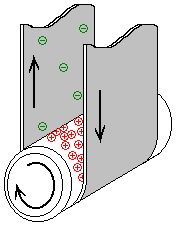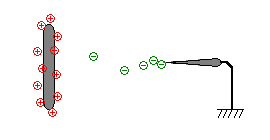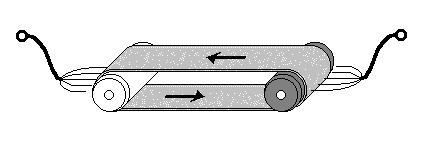Physics of Van de Graaff
Generators
Now that you have a firm understanding of
electrostatics, we can now delve into the actual workings of a Van de Graaff
generator. A Van de Graaff generator is used to create high amounts of static
electricity to be used for experimentation.
In 1931, an American Physicist named Robert Jemison Van
de Graaff invented his generator. He originally invented the generator to be
used for particle accelerators. These accelerators were known as atom smashers
and were used to create high energy waves such as X-rays.
There are two types of Van de Graaff generators, one
uses a belt drive system with a motor to turn the belt and charge the sphere,
and the other uses a high power supply to charge it. In this website we will
focus on the belt drive system for two reasons. One is that it is the original
system, and two is that it is much easier to build yourself one as most people
don’t generally come by extremely high voltage power sources on their
daily jog.
This type of generator uses an electric motor or hand
crank, two rollers, a belt, metallic brushes, and a metal sphere. When the motor
is on, it turns the lower roller which is covered in silicon tape. The roller
turns the rubber belt and begins to form a charge imbalance. You can see why
this imbalance occurs by looking at the triboelectric series.  Because
the silicon tape is more negative than the rubber, it begins capturing electrons
from the belt. Because the roller is much smaller than the belt, it has a much
larger concentration of charge. Because of this concentration, there is a much
stronger electric field formed around the roller than the belt. This strong
negative electric field on the roller does two things. It pushes away other
negative charges on sources around it, such as the lower brush assembly. The
brush is essentially just a bunch of small wire tips. Metals are basically positive
atoms surrounded by freely moving negative electrons. Because of the strong
negative field around the roller, the electrons on the wire tips are moved back,
creating a positive charge on the wire tips. It also begins to strip the air
molecules of their electrons. Now we have freely moving electrons and positive
air molecules floating around. The free electrons recombine with the electronless
wire tips, and the positive air molecules attract to the negatively charged
roller.
Because
the silicon tape is more negative than the rubber, it begins capturing electrons
from the belt. Because the roller is much smaller than the belt, it has a much
larger concentration of charge. Because of this concentration, there is a much
stronger electric field formed around the roller than the belt. This strong
negative electric field on the roller does two things. It pushes away other
negative charges on sources around it, such as the lower brush assembly. The
brush is essentially just a bunch of small wire tips. Metals are basically positive
atoms surrounded by freely moving negative electrons. Because of the strong
negative field around the roller, the electrons on the wire tips are moved back,
creating a positive charge on the wire tips. It also begins to strip the air
molecules of their electrons. Now we have freely moving electrons and positive
air molecules floating around. The free electrons recombine with the electronless
wire tips, and the positive air molecules attract to the negatively charged
roller.
Because the belt is in the way however, the positive
molecules can’t attach themselves to the negative charged and are instead
coated onto the belt, which is being carried away from the roller.
As long as there is air inside the generator, charges
can be created. The only limiting factor to the charge is impurities such as
dirt in the air. Now we have a positive belt moving toward the upper roller.
The upper brush assembly is made of metal as well, and the electrons in the
metal are attracted to the positive belt. Here again the air breaks down just
as before, and the positive nuclei are attracted to the brush, while the free
electrons are attracted to the belt. Since the upper brush is attached to the
metal sphere, any charge that the brush receives goes directly to the sphere.

Now the sphere is continually supplied with a positive
charge from the belt. This is essentially how a basic Van de Graaff generator
operates.
 Because
the silicon tape is more negative than the rubber, it begins capturing electrons
from the belt. Because the roller is much smaller than the belt, it has a much
larger concentration of charge. Because of this concentration, there is a much
stronger electric field formed around the roller than the belt. This strong
negative electric field on the roller does two things. It pushes away other
negative charges on sources around it, such as the lower brush assembly. The
brush is essentially just a bunch of small wire tips. Metals are basically positive
atoms surrounded by freely moving negative electrons. Because of the strong
negative field around the roller, the electrons on the wire tips are moved back,
creating a positive charge on the wire tips. It also begins to strip the air
molecules of their electrons. Now we have freely moving electrons and positive
air molecules floating around. The free electrons recombine with the electronless
wire tips, and the positive air molecules attract to the negatively charged
roller.
Because
the silicon tape is more negative than the rubber, it begins capturing electrons
from the belt. Because the roller is much smaller than the belt, it has a much
larger concentration of charge. Because of this concentration, there is a much
stronger electric field formed around the roller than the belt. This strong
negative electric field on the roller does two things. It pushes away other
negative charges on sources around it, such as the lower brush assembly. The
brush is essentially just a bunch of small wire tips. Metals are basically positive
atoms surrounded by freely moving negative electrons. Because of the strong
negative field around the roller, the electrons on the wire tips are moved back,
creating a positive charge on the wire tips. It also begins to strip the air
molecules of their electrons. Now we have freely moving electrons and positive
air molecules floating around. The free electrons recombine with the electronless
wire tips, and the positive air molecules attract to the negatively charged
roller.

